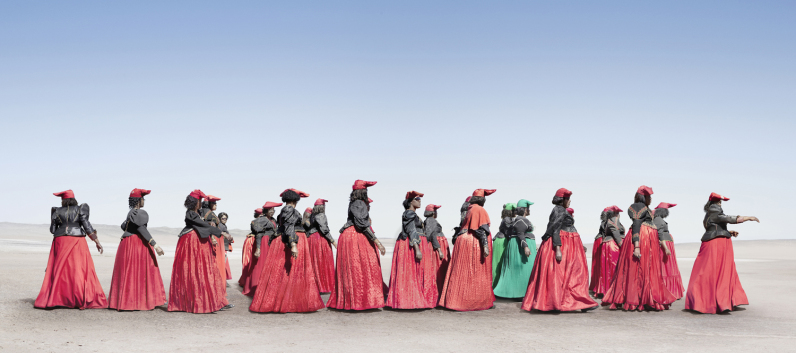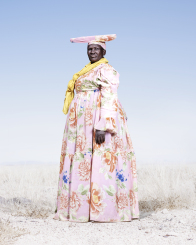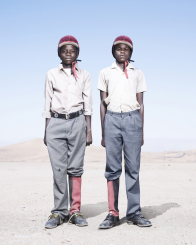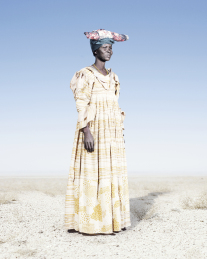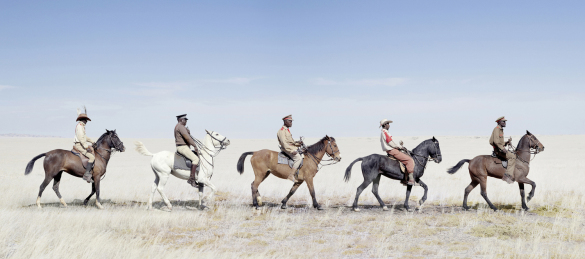Set against the searing intensity of the Namibian landscape, acclaimed photographer Jim Naughten’s dramatic portraits capture the magnificent costume of the Herero tribe. As this fascinating book reveals, the men’s paramilitary uniforms and the vibrant Victorian-style gowns worn by the women are a stark reminder of Namibia’s tumultuous past.
In the late nineteenth century, the influence of missionaries and traders in what became German South-West Africa led to the Herero women adopting the European dress of the day. Over time, this evolved to reflect their cultural identity, with the addition of horn-shaped headdresses representing the importance of cattle in Herero society. Rounded to resemble healthy cows, the dresses contain up to 10 metres of cloth, despite summer temperatures reaching 50oC.
The men’s distinctive ceremonial uniforms also have origins in colonial times. Following the brutal German-Herero war of 1904-08 and the end of colonial rule in 1915, the Herero adapted the uniforms of the German colonial forces for their own Otruppe (‘troops’) movement. In so doing, they sought to appropriate the strength and diminish the power of those who had cost them so dearly.
Hi Jim, how would you describe your style of photography?
I’m not entirely sure, but the portraits are generally typological, and I think my influences are probably fairly transparent. I would say that retouching ( oh for a better word for it ! ) is absolutely central to my practice, and as someone who used to paint it feels very natural and exiting to be able to transform the images in post production. I realise now that I always favoured abstraction - i.e. starting in black and white, and then cross processing or hand tinting prints, before finally coming around to the digital process.. I have started a new project although it doesn’t really help define my style, rather my interests, which are largely historical in nature.
What has inspired you to create “Conflict and Costume: The Herero tribe of Namibia”?
I traveled quite a bit in Africa after college and photographed the Herero people back then, but always wanted to go back and make a set of pictures in earnest. I was ( and remain ) entranced by Namibia and its peculiar history and people, and the Herero story is quite extraordinary. They are extremely photogenic too. I wanted to make one more project that had elements of documentary or reality in them before moving on, and this was the project I settled on making.
What message do you wish to convey through this series?
I would not say there is a specific message, but I am saying - in the simplest sense, ‘look at these people’ by lighting them, putting them centre- stage and using the desert for the backdrop. In doing that I want to draw attention to the clothing, and therefore the story behind it, and the history. I read a lot of history, and in fact there is a great one on the subject ( ‘The Kaisers Holocaust’ ) and not being a writer, the next best thing I can do is make some pictures on a subject that I find fascinating. Avedon said ‘photograph what you love’ and I try to follow this as much as possible. In that sense there was no ‘message’, rather an intuitive desire to make images and see where they go - I usually work this way around. Back to front !
Can you give us some information about a typical day shooting this series?
It took about four months, camping every day, striking camp, driving thousands of miles and photographing in villages, and at funerals and weddings, where we were invited. Our Herero guide would introduce us to village chiefs and elders where we would explain what we were hoping to do, and then bring them coffee, maize and sugar, and then if we could find people who were willing to be photographed we would take some pictures, usually between five and ten, and then make camp again, sometimes in the villages if we were permitted to stay.
Thank you so much for your time today Jim. Here’s our last question: if we were to send you to a desert island and allowing you to take with you only one picture taken by another photographer. What would this image be?
Visit Jim’s website to view the entire series: http://jimnaughten.com/
Exhibition
Venue: Klompching Gallery, 111 Front St #206 Brooklyn, NY 11201
Open: 13th March - 4th May 2013
For more information about the exhibition please visit http://www..klompching.com
Book
Title: Conflict and Costume: The Herero Tribe of Namibia
Publisher: Merrell Publishers Ltd
Photographs by Jim Naughten Introduction by Dr Lutz Marten
75 Illustrations, 1 map, 108 pages
Price: £30, hardback
For more information about the book, please contact: Elizabeth of Mar [email protected]

